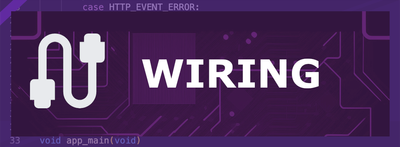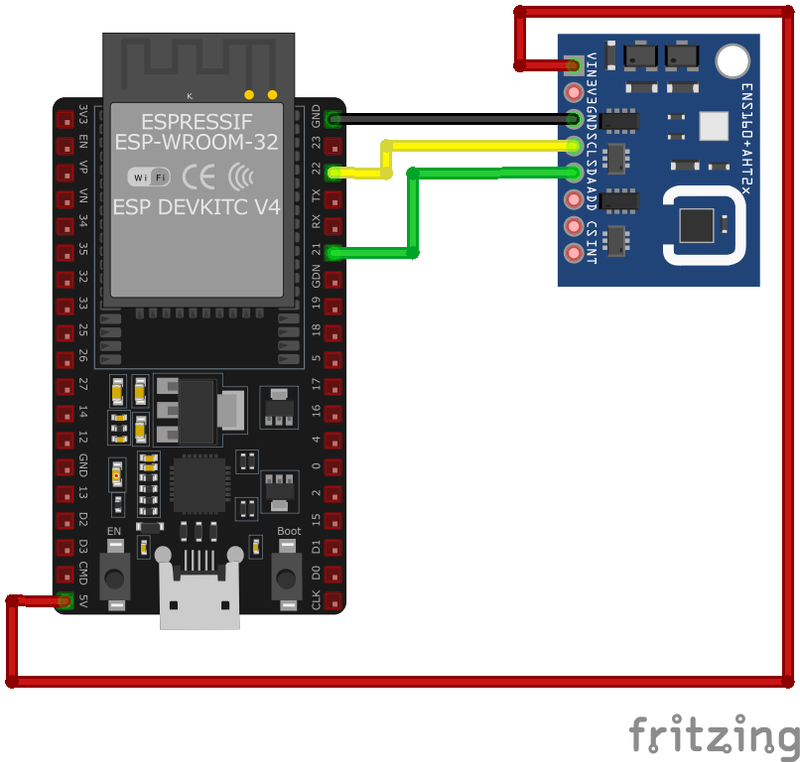ESP32 ENS160 Digital Metal-Oxide Multi-Gas Sensor
The ENS160 is a digital MOX gas sensor optimized for indoor air quality monitoring. It provides accurate measurements of TVOC and eCO₂ levels, along with AQIs, making it ideal for applications in building automation, HVAC systems, and air purifiers. The sensor supports both I²C and SPI interfaces, allowing for flexible integration into various microcontroller platforms.
🔗 Quick Links
🛒 ENS160 Price
ℹ️ About ENS160 Digital Metal-Oxide Multi-Gas Sensor
The ENS160 is a high-precision metal-oxide (MOX) multi-gas sensor designed for indoor air quality monitoring. It detects total volatile organic compounds (TVOC) and equivalent CO₂ (eCO₂) levels, providing real-time air quality indices (AQIs).
⚡ Key Features #
- Multi-Gas Detection – Measures TVOC, eCO₂, and gases like ethanol, toluene, hydrogen, and nitrogen dioxide.
- Four Independent MOX Sensor Elements – Each with its own hotplate control for enhanced selectivity and accuracy.
- Superior Air Quality Monitoring – More precise than standard sensors like the CCS811, with improved gas selectivity.
- I²C Communication – Seamless integration with ESP32, Arduino, and other microcontrollers.
With its advanced detection capabilities, the ENS160 is ideal for HVAC systems, smart home air monitoring, and industrial applications. 🚀
⚙️ ENS160 Sensor Technical Specifications
Below you can see the ENS160 Digital Metal-Oxide Multi-Gas Sensor Technical Specifications. The sensor is compatible with the ESP32, operating within a voltage range suitable for microcontrollers. For precise details about its features, specifications, and usage, refer to the sensor’s datasheet.
- Type: airQuality
- Protocol: I2C
- Measurement Parameters: TVOC, eCO₂, AQI
- Operating Voltage: 1.71V to 1.98V (VDD); 1.71V to 3.6V (VDDIO)
- Interface: I²C, SPI
- Operating Temperature: -40°C to 85°C
- Operating Humidity: 5% to 95% RH (non-condensing)
- Package: 3 x 3 x 0.9 mm LGA
🔌 ENS160 Sensor Pinout
Below you can see the pinout for the ENS160 Digital Metal-Oxide Multi-Gas Sensor. The VCC pin is used to supply power to the sensor, and it typically requires 3.3V or 5V (refer to the datasheet for specific voltage requirements). The GND pin is the ground connection and must be connected to the ground of your ESP32!
The ENS160 pinout is as follows:
- VIN: Power supply input (1.71V to 1.98V).
- GND: Ground connection.
- SDA: I²C data line.
- SCL: I²C clock line.
- INT: Interrupt output (optional).
- WAKE: Wake-up control input.
- ADDR: I²C address selection.
- CS: Chip select for SPI interface (tie to GND for I²C mode).
🧵 ENS160 Wiring with ESP32
Below you can see the wiring for the ENS160 Digital Metal-Oxide Multi-Gas Sensor with the ESP32. Connect the VCC pin of the sensor to the 3.3V pin on the ESP32 or external power supply for power and the GND pin of the sensor to the GND pin of the ESP32. Depending on the communication protocol of the sensor (e.g., I2C, SPI, UART, or analog), connect the appropriate data and clock or signal pins to compatible GPIO pins on the ESP32, as shown below in the wiring diagram.
VIN to the 3.3V or 5V power supply (depending on the breakout board specifications), GND to ground, SDA to the microcontroller's SDA pin, and SCL to the microcontroller's SCL pin. Ensure that appropriate pull-up resistors are present on the I²C lines if not already provided on the breakout board. For SPI communication, additional connections and configurations are required as per the sensor's datasheet.🛠️ ENS160 Digital Metal-Oxide Multi-Gas Sensor Troubleshooting
This guide outlines a systematic approach to troubleshoot and resolve common problems with the . Start by confirming that the hardware connections are correct, as wiring mistakes are the most frequent cause of issues. If you are sure the connections are correct, follow the below steps to debug common issues.
💻 Compilation Error: 'TwoWire::begin(uint8_t&, uint8_t&)'
Issue: When compiling code for the ENS160 sensor, the following error occurs: no matching function for call to 'TwoWire::begin(uint8_t&, uint8_t&)'.
Possible causes include the sensor library attempting to call a non-standard Wire.begin() function with two arguments, which is not supported by all platforms.
Solution: Modify the library code to use the standard Wire.begin() function without arguments. Specifically, in the ScioSense_ENS160.cpp file, locate the _i2c_init() function and replace its contents with a single call to Wire.begin();. This change ensures compatibility across different platforms.
❌ ENS160 Readings Unavailable in ESPHome
Issue: The ENS160 sensor intermittently reports unavailable readings in ESPHome, with log messages indicating: ENS160 readings unavailable - Normal Operation but readings not ready.
Possible causes include insufficient power supply stability, especially when the sensor is combined with other components like the AHT21.
Solution: Enhance the power supply stability by adding a supplemental capacitor to the sensor's power lines. This addition helps prevent voltage dropouts and ensures consistent sensor operation.
⚠️ ENS160 Fails to Initialize with WiFi Enabled on ESP32
Issue: When using the ENS160 sensor with an ESP32, enabling WiFi causes the sensor to report zero or no data on all channels.
Possible causes include resource conflicts or timing issues between the WiFi module and the I2C communication used by the sensor.
Solution: Investigate potential conflicts between the WiFi and I2C peripherals on the ESP32. Ensure that the I2C bus is properly configured and consider adjusting the I2C clock speed. Additionally, test the setup with WiFi disabled to confirm that the issue is related to WiFi interference.
❌ ENS160 Not Detected on I2C Bus
Issue: The ENS160 sensor is not recognized on the I2C bus, leading to initialization failures.
Possible causes include incorrect I2C address configuration or improper wiring.
Solution: Verify the sensor's I2C address, which can be either 0x52 or 0x53, depending on the state of the address selection pin (ASW). Ensure that the ASW pin is set correctly to match the expected address in your code. Additionally, check all wiring connections for correctness and secure contact.
💻 Code Examples
Below you can find code examples of ENS160 Digital Metal-Oxide Multi-Gas Sensor with ESP32 in several frameworks:
If you encounter issues while using the ENS160 Digital Metal-Oxide Multi-Gas Sensor, check the Common Issues Troubleshooting Guide.

ESP32 ENS160 Arduino IDE Code Example
Fill in your main Arduino IDE sketch file with the following code to use the ENS160 Digital Metal-Oxide Multi-Gas Sensor:
#include <Wire.h>
#include "ScioSense_ENS160.h"
ScioSense_ENS160 ens160(ENS160_I2CADDR_1); // I²C address 0x53
void setup() {
Serial.begin(115200);
Wire.begin();
if (!ens160.begin()) {
Serial.println("Failed to initialize ENS160 sensor!");
while (1);
}
}
void loop() {
ens160.readData();
Serial.print("eCO2: ");
Serial.print(ens160.geteCO2());
Serial.print(" ppm, TVOC: ");
Serial.print(ens160.getTVOC());
Serial.print(" ppb, AQI: ");
Serial.println(ens160.getAQI());
delay(1000);
}This Arduino sketch interfaces with the ENS160 sensor over I²C. It initializes the sensor using the ScioSense_ENS160 library with the I²C address set to 0x53. In the setup() function, the sensor is initialized, and an error message is displayed if initialization fails. The loop() function reads eCO₂, TVOC, and AQI data from the sensor every second and prints the values to the Serial Monitor.
Connect your ESP32 to your computer via a USB cable, Ensure the correct Board and Port are selected under Tools, Click the "Upload" button in the Arduino IDE to compile and upload the code to your ESP32.

ESP32 ENS160 ESP-IDF Code ExampleExample in Espressif IoT Framework (ESP-IDF)
If you're using ESP-IDF to work with the ENS160 Digital Metal-Oxide Multi-Gas Sensor, here's how you can set it up and read data from the sensor. Fill in this code in the main ESP-IDF file:
#include <stdio.h>
#include "driver/i2c.h"
#include "ens160.h"
#define I2C_MASTER_SCL_IO 22
#define I2C_MASTER_SDA_IO 21
#define I2C_MASTER_NUM I2C_NUM_0
#define I2C_MASTER_FREQ_HZ 100000
void app_main(void) {
i2c_config_t i2c_config = {
.mode = I2C_MODE_MASTER,
.sda_io_num = I2C_MASTER_SDA_IO,
.scl_io_num = I2C_MASTER_SCL_IO,
.sda_pullup_en = GPIO_PULLUP_ENABLE,
.scl_pullup_en = GPIO_PULLUP_ENABLE,
.master.clk_speed = I2C_MASTER_FREQ_HZ
};
i2c_param_config(I2C_MASTER_NUM, &i2c_config);
i2c_driver_install(I2C_MASTER_NUM, I2C_MODE_MASTER, 0, 0, 0);
ens160_t sensor;
ens160_init(&sensor, I2C_MASTER_NUM, ENS160_I2C_ADDRESS_1);
printf("Initializing ENS160\n");
if (ens160_start(&sensor) != ENS160_OK) {
printf("Failed to start ENS160 sensor\n");
return;
}
while (1) {
uint16_t eco2, tvoc;
uint8_t aqi;
if (ens160_read_data(&sensor, &eco2, &tvoc, &aqi) == ENS160_OK) {
printf("eCO2: %d ppm, TVOC: %d ppb, AQI: %d\n", eco2, tvoc, aqi);
} else {
printf("Error reading data from ENS160\n");
}
vTaskDelay(pdMS_TO_TICKS(1000));
}
}This ESP-IDF example interfaces with the ENS160 sensor over I²C using SDA (GPIO21) and SCL (GPIO22). The I²C bus is initialized with the appropriate configuration, and the ENS160 is configured to start data acquisition. In the main loop, eCO₂, TVOC, and AQI values are read every second and printed to the console. Any errors during communication are handled with error messages.
Update the I2C pins (I2C_MASTER_SDA_IO and I2C_MASTER_SCL_IO) to match your ESP32 hardware setup, Use idf.py build to compile the project, Use idf.py flash to upload the code to your ESP32.

ESP32 ENS160 ESPHome Code Example
Fill in this configuration in your ESPHome YAML configuration file (example.yml) to integrate the ENS160 Digital Metal-Oxide Multi-Gas Sensor
i2c:
sda: GPIO21
scl: GPIO22
sensor:
- platform: ens160
eco2:
name: "eCO2"
tvoc:
name: "TVOC"
aqi:
name: "Air Quality Index"
address: 0x53
update_interval: 1sThe ESPHome configuration sets up I²C communication with the ENS160 sensor using SDA (GPIO21) and SCL (GPIO22). The sensor platform fetches eCO₂, TVOC, and AQI data at 1-second intervals. The data is displayed as named sensors: 'eCO2', 'TVOC', and 'Air Quality Index'. The I²C address is set to 0x53.
Upload this code to your ESP32 using the ESPHome dashboard or the esphome run command.

ESP32 ENS160 PlatformIO Code Example
For PlatformIO, make sure to configure the platformio.ini file with the appropriate environment and libraries, and then proceed with the code.
Configure platformio.ini
First, your platformio.ini should look like below. You might need to include some libraries as shown. Make sure to change the board to your ESP32:
[env:esp32dev]
platform = espressif32
board = esp32dev
framework = arduino
monitor_speed = 115200ESP32 ENS160 PlatformIO Example Code
Write this code in your PlatformIO project under the src/main.cpp file to use the ENS160 Digital Metal-Oxide Multi-Gas Sensor:
#include <Wire.h>
#include "ScioSense_ENS160.h"
ScioSense_ENS160 ens160(ENS160_I2CADDR_1); // I²C address 0x53
void setup() {
Serial.begin(115200);
Wire.begin(21, 22); // SDA: GPIO21, SCL: GPIO22
if (!ens160.begin()) {
Serial.println("Failed to initialize ENS160 sensor!");
while (1);
}
}
void loop() {
ens160.readData();
Serial.print("eCO2: ");
Serial.print(ens160.geteCO2());
Serial.print(" ppm, TVOC: ");
Serial.print(ens160.getTVOC());
Serial.print(" ppb, AQI: ");
Serial.println(ens160.getAQI());
delay(1000);
}This PlatformIO example interfaces with the ENS160 sensor using SDA (GPIO21) and SCL (GPIO22). The sensor is initialized with the I²C address set to 0x53. eCO₂, TVOC, and AQI values are retrieved in the loop() and printed to the Serial Monitor every second.
Upload the code to your ESP32 using the PlatformIO "Upload" button in your IDE or the pio run --target upload command.

ESP32 ENS160 MicroPython Code Example
Fill in this script in your MicroPython main.py file (main.py) to integrate the ENS160 Digital Metal-Oxide Multi-Gas Sensor with your ESP32.
from machine import I2C, Pin
import time
# ENS160 I2C address
ENS160_ADDR = 0x53
# Register addresses
DATA_ECO2 = 0x22
DATA_TVOC = 0x24
DATA_AQI = 0x26
# Initialize I2C
i2c = I2C(0, scl=Pin(22), sda=Pin(21))
# Function to read 16-bit register
def read_register(addr, reg):
data = i2c.readfrom_mem(addr, reg, 2)
return (data[0] << 8) | data[1]
while True:
eco2 = read_register(ENS160_ADDR, DATA_ECO2)
tvoc = read_register(ENS160_ADDR, DATA_TVOC)
aqi = i2c.readfrom_mem(ENS160_ADDR, DATA_AQI, 1)[0]
print(f"eCO2: {eco2} ppm, TVOC: {tvoc} ppb, AQI: {aqi}")
time.sleep(1)This MicroPython script interfaces with the ENS160 sensor over I²C using SDA (GPIO21) and SCL (GPIO22). It reads eCO₂, TVOC, and AQI data by accessing the corresponding registers. The read_register() function retrieves 16-bit data from the sensor. The main loop continuously fetches and prints the sensor values every second.
Upload this code to your ESP32 using a MicroPython-compatible IDE, such as Thonny, uPyCraft, or tools like ampy.
Conclusion
We went through technical specifications of ENS160 Digital Metal-Oxide Multi-Gas Sensor, its pinout, connection with ESP32 and ENS160 Digital Metal-Oxide Multi-Gas Sensor code examples with Arduino IDE, ESP-IDF, ESPHome and PlatformIO.



















